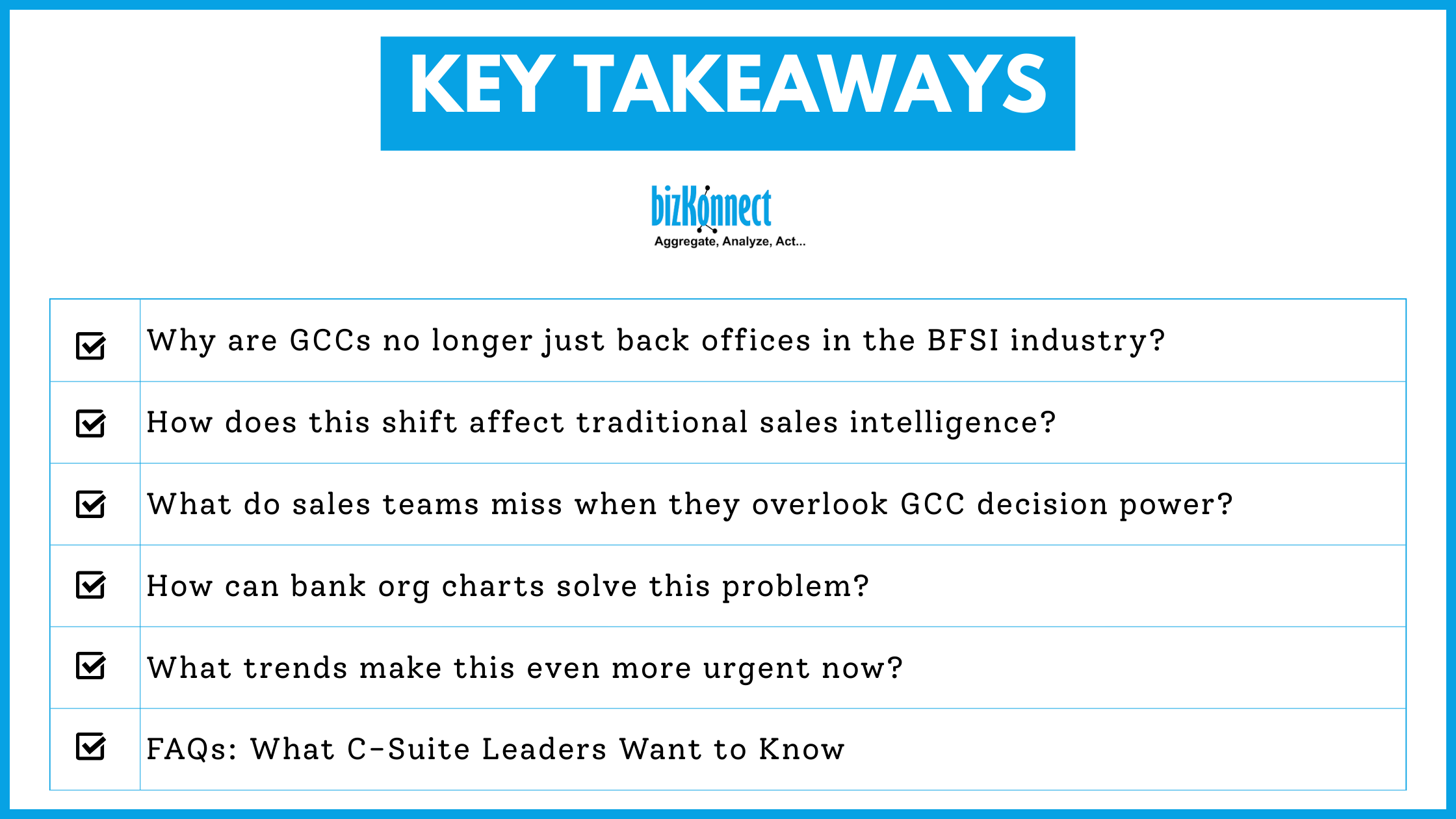The BFSI industry nowadays no longer runs through linear hierarchies. Decision-making has shifted into matrixed networks where global capability centers (GCCs) are shaping strategies for AI, compliance, and digital transformation.

To navigate this environment, dynamic GenAI-driven bank org charts have become essential. They capture how responsibilities actually shift across headquarters and GCCs, giving sales teams a contextual view of influence and authority.
But why are GCCs no longer just back offices in the BFSI industry?
The global BFSI industry is evolving at record speed. Financial services alone are on track to contribute to a USD 25.7 trillion market by 2026. With such scale, the old model of headquarters-only decision-making is no longer sustainable.
GCCs have taken on leadership roles in:
- AI and Fintech integration: From robo-advisors in WealthTech to blockchain-led decentralized finance (DeFi), many pilots are now led by GCC teams who manage vendor partnerships and compliance.
- Digital transformation: GCCs drive implementation of cloud-first platforms, IT modernization, and fintech collaborations.
- Compliance and ESG (Environmental, Social, Governance): Global banks increasingly centralize risk management, regulatory controls, and ESG data monitoring within GCCs.
This evolution means that the organizational chart for a bank is no longer siloed into headquarters vs. execution. Instead, GCCs are embedded as decision nerve centers, shaping strategies and co-owning P&L (profit and loss) outcomes.
How does this shift affect traditional sales intelligence?
Conventional sales intelligence focuses on static hierarchies - who reports to whom, which department signs the budget, and which executive owns a given initiative. That works in an old-world setup.
But in BFSI, where the global fintech market is projected to grow at a CAGR of 16.8% from 2023 to 2030, responsibility is distributed across matrixed structures. For example:
- The org chart of a bank with IT and fintech partnerships will show innovation being co-owned by Chief Information Officers, Heads of AI R&D, and GCC-based partnership leads.
- A bank organizational chart with roles and responsibilities around compliance will reveal joint accountability between Chief Risk Officers at HQ and compliance directors inside GCCs.
- BFSI industry org charts with fintech and digital services divisions show overlap between digital banking units, fintech liaisons, and product leads - all spread across HQ and GCC locations.
Without a dynamic, contextual view of these structures, sales teams end up pitching to the wrong nodes in the matrix - or worse, treating influencers as decision-makers.
What do sales teams miss when they overlook GCC decision power?
Many sales teams still assume:
- Budgets = Headquarters
- Execution = GCCs
This oversimplification is costly because more than 60% of BFSI GCCs now manage global digital transformation programs end-to-end. That means they not only evaluate solutions but also control the shortlisting and final decision process.
Missing GCC stakeholders leads to:
- Longer sales cycles, because you’re re-routing proposals after approvals stall.
- Reduced trust, since your messaging appears disconnected from the real decision environment.
- Competitors gaining the advantage by engaging decision-makers you never reached.

How can bank org charts solve this problem?
Unlike static charts, dynamic GenAI-driven bank org charts are intelligent systems that continuously learn from multiple signals inside and outside the enterprise.
Here’s what makes them different:
- Data Fusion Across Sources: GenAI-driven bank org charts integrate information from HR feeds, regulatory filings, fintech partnership announcements, ESG disclosures, and even leadership job postings. This ensures that what you see is an updated business map.
- Accurate and Actionable Updates: Traditional charts go stale the moment responsibilities shift. GenAI models continuously update roles, projects, and reporting paths, reflecting actual business reality inside BFSI companies.
- Contextual Roles and Responsibilities: Instead of just showing titles like “VP of Digital Banking,” these charts clarify what the role owns - cloud migration, AI-driven fraud detection, or fintech collaboration. Sales teams can directly map offerings to responsibilities.
- Multi-Path Navigation: GenAI-powered org charts highlight alternate routes of influence, so if a CIO in New York is hard to reach, you immediately see that a Head of Compliance in a Bengaluru GCC co-owns the same transformation initiative.
- Predictive Stakeholder Insights: Beyond the current structure, these charts surface emerging roles such as “Head of AI Governance” or “Director of ESG Data Strategy” that are rapidly becoming decision-makers across the BFSI ecosystem.
What trends make this even more urgent now?
The BFSI landscape is experiencing simultaneous disruptions:
- WealthTech growth: Robo-advisors and AI-driven investment planning are projected to push the wealth management market to USD 1.6 trillion by 2027. Often, partnership decisions are initiated in GCCs.
- Insurance digitization: The global InsurTech market is expected to hit USD 152.4 billion by 2030 where GCCs lead initiatives in IoT-driven risk assessment and AI-led claims.
- Regulatory compliance: With stricter global regimes on data protection and ESG, GCC compliance offices are no longer observers. They set rules for fintech vendors and IT providers.
Together, these shifts make it impossible to rely on traditional sales intelligence alone.
The BFSI industry org chart with fintech and digital services divisions no longer tells a story of top-down control. It tells a story of matrixed power where GCCs shape the future of AI adoption, fintech integration, and compliance strategy.
For sales teams, this means success depends not on outdated assumptions but on embracing dynamic, GenAI-driven bank org charts that reveal the real decision nerve centers.
FAQs: What C-Suite Leaders Want to Know
Q1: How do GCC-led decisions impact global vendor partnerships?
GCCs often act as the first point of evaluation for fintech and IT partners. Their recommendations shape final HQ approvals. Ignoring them risks being locked out early in the process.
Q2: Can one org chart capture such complexity?
Yes, when powered by GenAI, org charts integrate data from multiple sources to highlight reporting lines, cross-functional teams, and decision overlaps. This transforms static hierarchies into living maps.
Q3: How do these charts help shorten sales cycles?
By identifying multiple pathways to decision-makers, sales teams avoid bottlenecks. Instead of waiting for one contact to escalate, you engage parallel stakeholders aligned with their roles and responsibilities.
Q4: Are GCCs relevant only for tech-driven solutions?
No. While AI and digital services are a strong focus, GCCs also oversee compliance, risk, and ESG priorities, making them key stakeholders for diverse solutions across the BFSI spectrum.
Get a glimpse into your target account’s real structure with BizKonnect. Request an org chart sample.